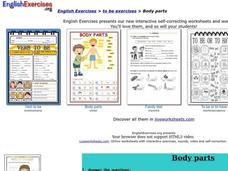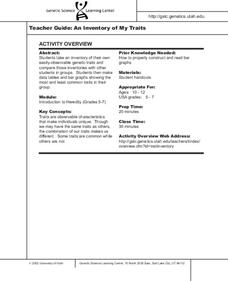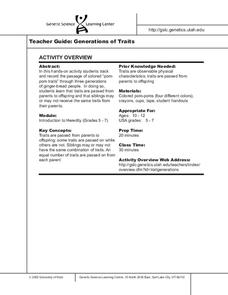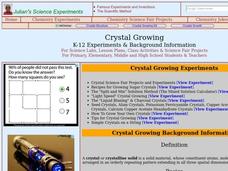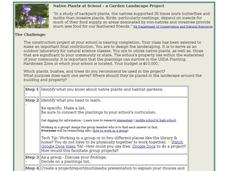Curated OER
Ecological Relationships
Students identify ecological elements and their factors on species, populations and food webs. They analyze ecosystems for these elements and research how these factors influence species survival rate. Predictions on conditions over time...
Curated OER
Extra! Extra!
Students describe how plants and animals depend on each other. They see how living and nonliving environments change over time. They identify ways in which humans have changed their environment and the effects of those changes.
Curated OER
Medieval Catapults
Students design and build a working catapult or trebuchet to explore the concepts of force, motion, and distance.
Curated OER
Your Amazing Body
Students examine the different body systems and how they are interdependent on each other. In this body systems activity students draw the body and its parts.
Curated OER
Body Parts
In this human biology interactive worksheet, students answer 13 questions based on their knowledge of the human body. There are eight multiple choice questions and five fill-in questions.
Curated OER
Body Parts
In this interactive human biology learning exercise, learners read ten riddles about body parts and type in the appropriate name of the body part the riddle is describing. Students also answer a nine word crossword puzzle that focuses on...
Curated OER
Lemon Battery
Students construct their own battery made of lemons. In this electrochemistry lesson, students explain why lemons conduct electricity. They perform a series of experiments to investigate its conductivity.
Curated OER
An Inventory of My Traits
Students take an inventory of their own easily-observable genetic traits and
compare those inventories with other students in groups. They then make
data tables and bar graphs showing the most and least common traits in their group.
Curated OER
Through the Eyes of an Owl
Students describe vertebrates in terms of observable body parts and characteristics and describe life cycles of familiar organisms. They identify familiar organisms as part of a food chain or food web and describe their feeding...
Curated OER
An Inventory of My Traits
In this biology activity, students identify and describe a number of easily observable genetic traits and compare the traits they have with other students. Then they identify and describe that some traits are common while others are not...
Curated OER
The Colors of Seasons
Students observe each season and and mark the colors they see. In this colors of the seasons lessons, students read The Mystery of the Missing Hummingbirds and compare their results and note variations of colors in the different...
Curated OER
Which Part of the Great Salt Lake Stinks More?
Students research background knowledge of the Great Salt Lake prior to a field trip. They identify specific wild life at the Great Salt Lake on the field trip and identify the islands in the Great Salt Lake. They present their...
Curated OER
Generations of Traits
In this biology activity, students track and record the passage of colored pom pom traits through three generations of ginger-bread people. Then they describe that traits are passed from parents to offspring and that siblings may or may...
Curated OER
Maglev Trains
Students explore how Maglev trains work. In this technology instructional activity, students discuss the pros and cons of Maglev compared to conventional trains. They build a simple Maglev train model.
Curated OER
The Nature of Chemical Change: Acting Out an Example
Students identify the signs that a chemical reaction took place. In this chemistry lesson, students role play the movement of different molecules of matter. They classify matter according to their properties.
Curated OER
Gene Puzzles
Students come to understand that in sexually reproducing organisms, such as humans, typically half of the genes come from each parent.
Students examine a fictional pedigree and determine which gene is responsible for a given trait. The...
Curated OER
Ants
Third graders study the habits and habitats of ants. They research the use of technology as a valuable investigation tool and access other web sites for future research projects. The students make successful decisions while playing SimAnt.
Curated OER
Where are the Dinosaurs?
Young scholars construct their own diorama based on the life of a dinosaur. In this dinosaur lesson, students create models of dinosaurs and dinosaurs' eggs to explore the life cycle of this extinct species.
Curated OER
Tropism
Students conduct various experiments on tropism. In this biology lesson, students explain how gravity affects the growth of plant roots. They identify the different types of tropisms.
Curated OER
Zoo Habitat Design
Students design a zoo habitat for an animals. In this zoo habitat lesson, students develop an idea for a zoo habitat that would meet the needs of a specific animal. They solve problems that might be encountered by using their knowledge...
Curated OER
Crystal Growing
Students explore the different phases of a crystal. In this mineral lesson students grow their own sugar crystals using a sugar recipe.
Curated OER
Human Body Simon Says
Learners display their new knowledge of human body parts' names and locations, by playing an adaptation of the game Simon Says. A more sophisticated version of the game can be played with older students as they learn more specific names...
Curated OER
Matter for Minors
Students use streaming videos, web sites, and hands on activities students to explore matter. They focus on how temperature affects matter and what the particles look like in the states of matter.
Curated OER
Native Plants at School -- A Garden Landscape Project
In this native plants at school -- a garden landscape project instructional activity, students design the landscape for a school garden by identifying native plants, creating a presentation and creating a plot plan within the...




